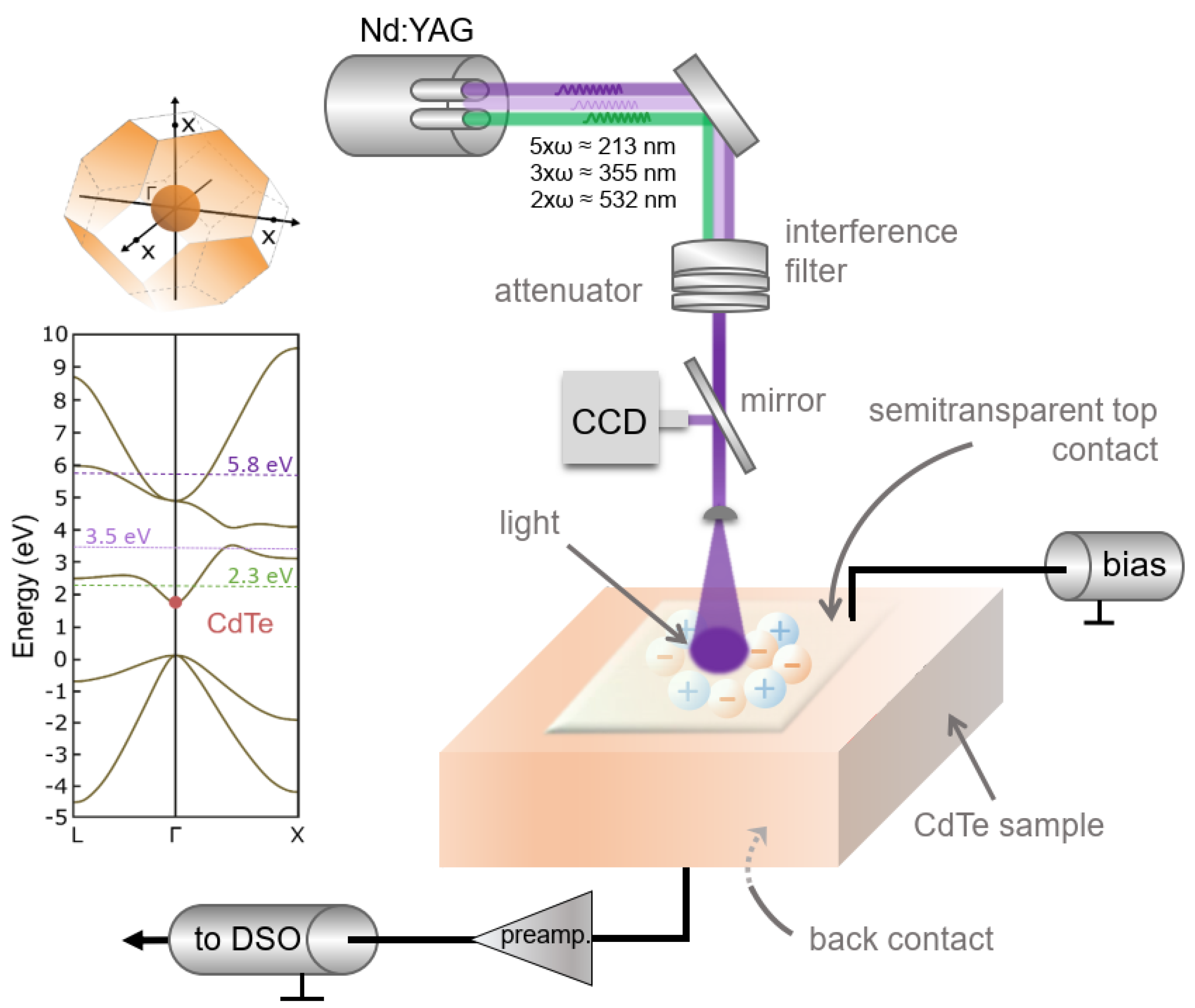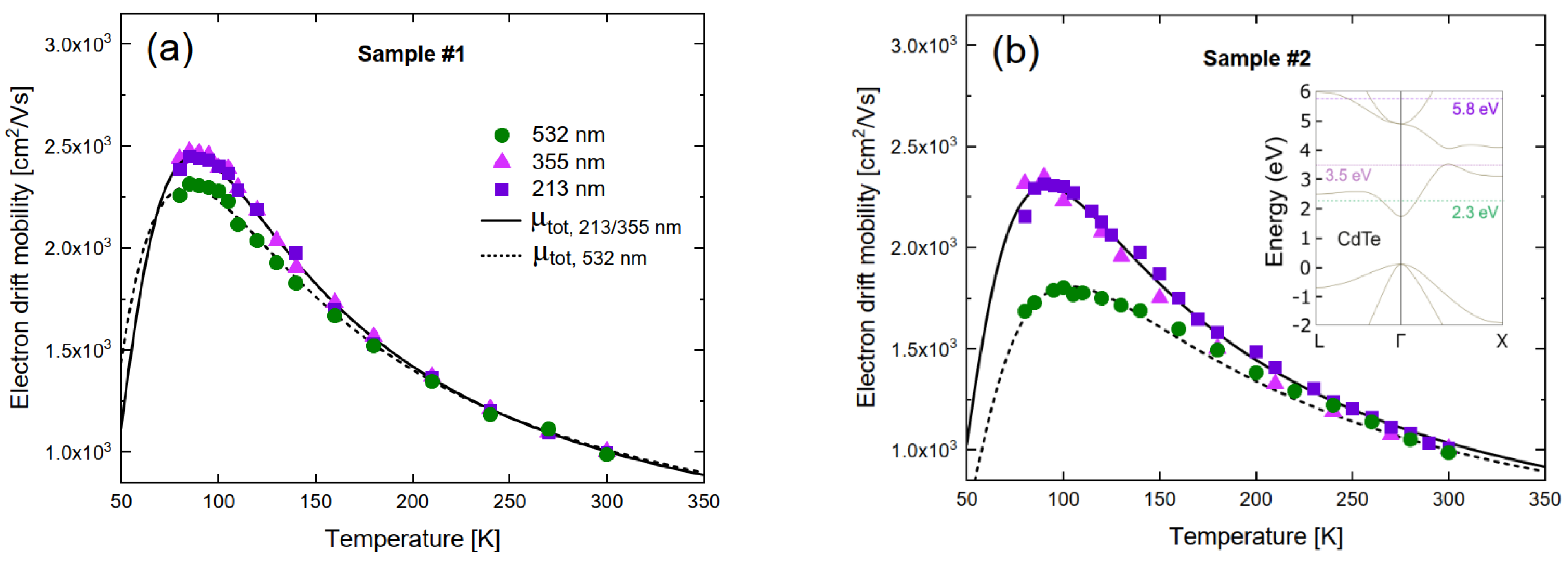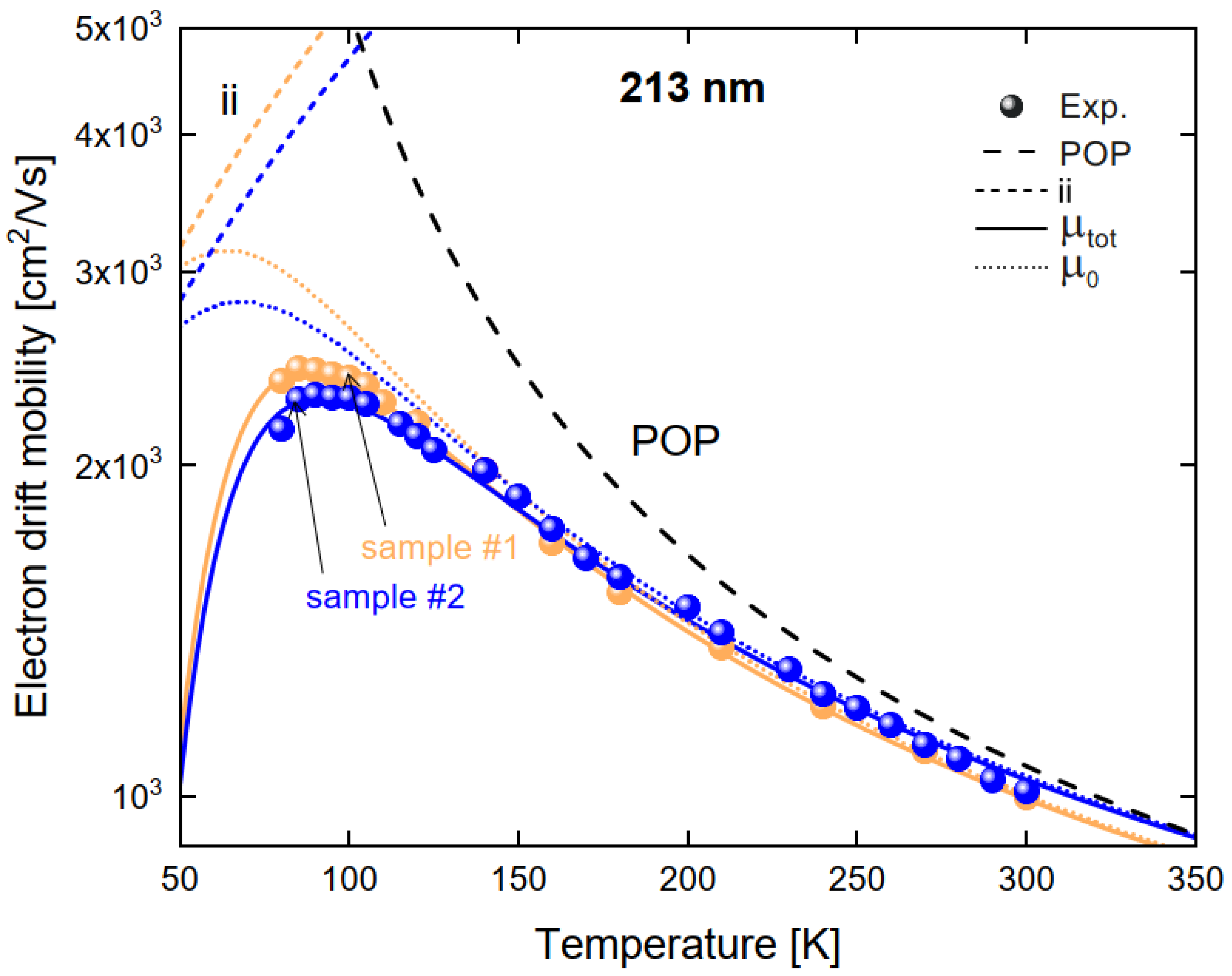Investigation of Photoexcitation Energy Impact on Electron Mobility in Single Crystalline CdTe
Abstract
:1. Introduction
2. Materials and Methods
3. Results and Discussion
4. Conclusions
Author Contributions
Funding
Institutional Review Board Statement
Informed Consent Statement
Data Availability Statement
Conflicts of Interest
References
- Ropagnol, X.; Matoba, M.; Nkeck, J.E.; Blanchard, F.; Isgandarov, E.; Yumoto, J.; Ozaki, T. Efficient Terahertz Generation and Detection in Cadmium Telluride Using Ultrafast Ytterbium Laser. Appl. Phys. Lett. 2020, 117, 181101. [Google Scholar] [CrossRef]
- Zanio, K.; Pollak, F.H. Semiconductors and Semimetals, Vol. 13 (Cadmium Telluride). Phys. Today 1978, 31, 53–54. [Google Scholar] [CrossRef]
- Triboulet, R.; Marfaing, Y.; Cornet, A.; Siffert, P. Undoped High-resistivity Cadmium Telluride for Nuclear Radiation Detectors. J. Appl. Phys. 1974, 45, 2759–2765. [Google Scholar] [CrossRef]
- Takahashi, T.; Watanabe, S. Recent Progress in CdTe and CdZnTe Detectors. IEEE Trans. Nucl. Sci. 2001, 48, 950–959. [Google Scholar] [CrossRef] [Green Version]
- Oliver, M.R.; Foyt, A.G. The Gunn Effect in N-CdTe. IEEE Trans. Electron Devices 1967, 14, 617–618. [Google Scholar] [CrossRef]
- Funaki, M.; Ozaki, T.; Satoh, K.; Ohno, R. Growth and Characterization of CdTe Single Crystals for Radiation Detectors. Nucl. Instrum. Methods Phys. Res. Sect. A Accel. Spectrometers Detect. Assoc. Equip. 1999, 436, 120–126. [Google Scholar] [CrossRef]
- Chen, H.; Awadalla, S.A.; Mackenzie, J.; Redden, R.; Bindley, G.; Bolotnikov, A.E.; Camarda, G.S.; Carini, G.; James, R.B. Characterization of Traveling Heater Method (THM) Grown Cd0.9Zn0.1Te Crystals. IEEE Trans. Nucl. Sci. 2007, 54, 811–816. [Google Scholar] [CrossRef]
- Segall, B.; Lorenz, M.R.; Halsted, R.E. Electrical Properties of n-Type CdTe. Phys. Rev. 1963, 129, 2471–2481. [Google Scholar] [CrossRef]
- Rode, D.L. Electron Mobility in II-VI Semiconductors. Phys. Rev. B 1970, 2, 4036–4044. [Google Scholar] [CrossRef]
- Rode, D.L. Electron Mobility in Direct-Gap Polar Semiconductors. Phys. Rev. B 1970, 2, 1012–1024. [Google Scholar] [CrossRef]
- Zanio, K.R.; Akutagawa, W.M.; Kikuchi, R. Transient Currents in Semi-Insulating CdTe Characteristic of Deep Traps. J. Appl. Phys. 1968, 39, 2818–2828. [Google Scholar] [CrossRef]
- Pernegger, H.; Roe, S.; Weilhammer, P.; Eremin, V.; Frais-Kölbl, H.; Griesmayer, E.; Kagan, H.; Schnetzer, S.; Stone, R.; Trischuk, W.; et al. Charge-Carrier Properties in Synthetic Single-Crystal Diamond Measured with the Transient-Current Technique. J. Appl. Phys. 2005, 97, 073704. [Google Scholar] [CrossRef] [Green Version]
- Canali, C.; Martini, M.; Ottaviani, G.; Zanio, K. Time of Flight Measurement of the Differential Negative Mobility in CdTe. Phys. Lett. A 1970, 33, 241–242. [Google Scholar] [CrossRef]
- Ottaviani, G.; Canali, C.; Jacoboni, C.; Quaranta, A.A.; Zanio, K. Hole Mobility and Poole-Frenkel Effect in CdTe. J. Appl. Phys. 1973, 44, 360–371. [Google Scholar] [CrossRef]
- Taguchi, T.; Shirafuji, J.; Inuishi, Y. Gamma and Electron Radiation Effects in CdTe. Nucl. Instrum. Methods 1978, 150, 43–48. [Google Scholar] [CrossRef]
- Nebel, C.E.; Münz, J.; Stutzmann, M.; Zachai, R.; Güttler, H. Electronic Properties of CVD and Synthetic Diamond. Phys. Rev. B 1997, 55, 9786–9791. [Google Scholar] [CrossRef]
- Majdi, S.; Kovi, K.K.; Hammersberg, J.; Isberg, J. Hole Transport in Single Crystal Synthetic Diamond at Low Temperatures. Appl. Phys. Lett. 2013, 102, 152113. [Google Scholar] [CrossRef]
- Pan, L.S.; Kania, D.R.; Pianetta, P.; Ager, J.W., III; Landstrass, M.I.; Han, S. Temperature Dependent Mobility in Single-Crystal and Chemical Vapor-Deposited Diamond. J. Appl. Phys. 1993, 73, 2888–2894. [Google Scholar] [CrossRef]
- Majdi, S.; Gabrysch, M.; Kovi, K.K.; Suntornwipat, N.; Friel, I.; Isberg, J. Low Temperature Conduction-Band Transport in Diamond. Appl. Phys. Lett. 2016, 109, 162106. [Google Scholar] [CrossRef]
- Isberg, J.; Majdi, S.; Gabrysch, M.; Friel, I.; Balmer, R.S. A Lateral Time-of-Flight System for Charge Transport Studies. Diam. Relat. Mater. 2009, 18, 1163–1166. [Google Scholar] [CrossRef]
- Gabrysch, M.; Majdi, S.; Twitchen, D.J.; Isberg, J. Electron and Hole Drift Velocity in Chemical Vapor Deposition Diamond. J. Appl. Phys. 2011, 109, 063719. [Google Scholar] [CrossRef] [Green Version]
- Isberg, J.; Gabrysch, M.; Majdi, S.; Kovi, K.K.; Twitchen, D. On the Transition between Space-Charge-Free and Space-Charge-Limited Conduction in Diamond. Solid State Sci. 2011, 13, 1065–1067. [Google Scholar] [CrossRef]
- Cola, A.; Farella, I.; Anni, M.; Martucci, M.C. Charge Transients by Variable Wavelength Optical Pulses in CdTe Nuclear Detectors. IEEE Trans. Nucl. Sci. 2012, 59, 1569–1574. [Google Scholar] [CrossRef]
- Shockley, W. Currents to Conductors Induced by a Moving Point Charge. J. Appl.Phys. 1938, 9, 635–636. [Google Scholar] [CrossRef]
- Ramo, S. Currents Induced by Electron Motion. IRE Proc. 1939, 27, 584–585. [Google Scholar] [CrossRef]
- Canali, C.; Martini, M.; Ottaviani, G.; Zanio, K.R. Transport Properties of CdTe. Phys. Rev. B 1971, 4, 422–431. [Google Scholar] [CrossRef]
- Isberg, J.; Gabrysch, M.; Tajani, A.; Twitchen, D.J. Transient Current Electric Field Profiling of Single Crystal CVD Diamond. Semicond. Sci. Technol. 2006, 21, 1193–1195. [Google Scholar] [CrossRef]
- Canali, C.; Ottaviani, G.; Bell, R.O.; Wald, F.V. Self-Compensation in CdTe. J. Phys. Chem. Solids 1974, 35, 1405–1413. [Google Scholar] [CrossRef]
- Schlesinger, T.E.; Toney, J.E.; Yoon, H.; Lee, E.Y.; Brunett, B.A.; Franks, L.; James, R.B. Cadmium Zinc Telluride and Its Use as a Nuclear Radiation Detector Material. Mater. Sci. Eng. R Rep. 2001, 32, 103–189. [Google Scholar] [CrossRef]
- Conwell, E.; Weisskopf, V.F. Theory of Impurity Scattering in Semiconductors. Phys. Rev. 1950, 77, 388–390. [Google Scholar] [CrossRef]
- Ehrenreich, H. Electron Mobility of Indium Arsenide Phosphide [In(AsyP1−y)]. J. Phys. Chem. Solids 1959, 12, 97–104. [Google Scholar] [CrossRef]
- Callen, H.B. Electric Breakdown in Ionic Crystals. Phys. Rev. 1949, 76, 1394–1402. [Google Scholar] [CrossRef]
- Lee, T.D.; Low, F.E.; Pines, D. The Motion of Slow Electrons in a Polar Crystal. Phys. Rev. 1953, 90, 297–302. [Google Scholar] [CrossRef]
- Howarth, D.J.; Sondheimer, E.H.; Jones, H. The Theory of Electronic Conduction in Polar Semi-Conductors. Proc. R. Soc. London. Ser. A. Math. Phys. Sci. 1953, 219, 53–74. [Google Scholar] [CrossRef]
- Pearsall, T. Alloy Scattering Effects and Calculated Mobility in N-Type Ga0.47In0.53As. Electron. Lett. 1981, 17, 169–170. [Google Scholar] [CrossRef]
- Saxena, A.K.; Mudares, M.A.L. Validity of Matthiessen’s Rule for Calculating Electron Mobility in Ga1−x Alx As alloys. J. Appl. Phys. 1985, 58, 2795–2797. [Google Scholar] [CrossRef]
- Takeda, Y.; Pearsall, T.P. Failure of Matthiessen’s Rule in the Calculation of Carrier Mobility and Alloy Scattering Effects in Ga0.47In0.53As. Electron. Lett. 1981, 17, 573–574. [Google Scholar] [CrossRef]
- Suzuki, K.; Sawada, T.; Imai, K. Effect of DC Bias Field on the Time-of-Flight Current Waveforms of CdTe and CdZnTe Detectors. IEEE Trans. Nucl. Sci. 2011, 58, 1958–1963. [Google Scholar] [CrossRef]




| Sample | Ni × 1016 [cm−3] | Nt × 1014 [cm−3] |
|---|---|---|
| # 1 | 6.4 ± 0.4 | 60 ± 12 |
| # 2 | 7.7 ± 0.8 | 55 ± 18 |
Publisher’s Note: MDPI stays neutral with regard to jurisdictional claims in published maps and institutional affiliations. |
© 2021 by the authors. Licensee MDPI, Basel, Switzerland. This article is an open access article distributed under the terms and conditions of the Creative Commons Attribution (CC BY) license (https://creativecommons.org/licenses/by/4.0/).
Share and Cite
Djurberg, V.; Majdi, S.; Suntornwipat, N.; Isberg, J. Investigation of Photoexcitation Energy Impact on Electron Mobility in Single Crystalline CdTe. Materials 2021, 14, 4202. https://doi.org/10.3390/ma14154202
Djurberg V, Majdi S, Suntornwipat N, Isberg J. Investigation of Photoexcitation Energy Impact on Electron Mobility in Single Crystalline CdTe. Materials. 2021; 14(15):4202. https://doi.org/10.3390/ma14154202
Chicago/Turabian StyleDjurberg, Viktor, Saman Majdi, Nattakarn Suntornwipat, and Jan Isberg. 2021. "Investigation of Photoexcitation Energy Impact on Electron Mobility in Single Crystalline CdTe" Materials 14, no. 15: 4202. https://doi.org/10.3390/ma14154202
APA StyleDjurberg, V., Majdi, S., Suntornwipat, N., & Isberg, J. (2021). Investigation of Photoexcitation Energy Impact on Electron Mobility in Single Crystalline CdTe. Materials, 14(15), 4202. https://doi.org/10.3390/ma14154202







